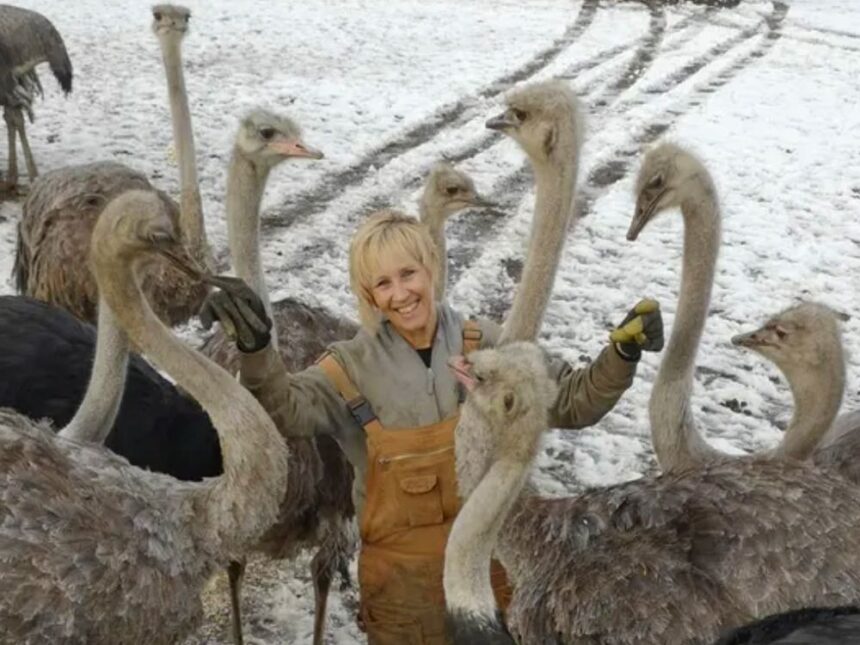The morning was eerily quiet when I pulled up to Peter Cobb’s farm in Knutsford, British Columbia. Three days earlier, these fields had echoed with the distinctive booming calls of his ostrich flock. Now, the remaining birds clustered nervously at the far end of their enclosure, as if sensing the tension that had engulfed the property.
“They’re like family,” Cobb told me, his voice breaking slightly as he leaned against the fence. “We’ve raised some of these birds from chicks. They recognize our voices, have their own personalities.”
The planned cull of Cobb’s 90 ostriches has been temporarily suspended after a tense standoff between the Canadian Food Inspection Agency (CFIA) and local farmers who rallied to support the embattled ostrich rancher. The dispute highlights growing tensions between federal disease management protocols and the economic and emotional realities faced by specialty livestock producers.
The conflict erupted after a single ostrich on Cobb’s farm tested positive for H5N1 avian influenza, commonly known as bird flu. Following established protocols, CFIA officials ordered the destruction of his entire flock to prevent potential spread of the highly contagious disease that has devastated poultry operations across North America since 2022.
“I understand the concern about disease spread,” Cobb explained as we walked the perimeter of his farm. “But these birds are worth between $8,000 to $25,000 each. That’s nearly $2 million in livestock. The compensation doesn’t come close to covering that.”
Federal compensation caps at just $1,400 per bird, leaving Cobb facing potential financial ruin if the cull proceeds.
When CFIA officials arrived Tuesday to begin the culling operation, they were met by approximately 40 local farmers and supporters who formed a blockade with their vehicles at the property entrance. The standoff continued for several hours before CFIA representatives retreated, temporarily halting the planned cull.
“I never expected this kind of support,” Cobb said, gesturing toward the makeshift camp several supporters had established near his driveway. “These are my neighbors, but also farmers who understand what’s at stake here.”
The dispute highlights the complex challenges in managing zoonotic disease outbreaks while balancing economic impacts on producers. Since 2022, the H5N1 strain has triggered the culling of millions of domestic birds across North America, with devastating consequences for both commercial operations and specialty producers.
Dr. Samantha Wong, a veterinary epidemiologist at the University of British Columbia who isn’t involved in the case, explained the dilemma. “The CFIA protocols follow international standards for disease containment, but there’s growing recognition that one-size-fits-all approaches may need reconsideration, especially with non-traditional livestock.”
Wong pointed out that while the science behind avian influenza containment is sound, the application of these policies can be problematic. “The question isn’t just about disease management, but about proportionality and whether we need more nuanced approaches for different species and production systems.”
For specialty livestock producers like Cobb, the current system creates particular hardships. Ostriches have different susceptibility profiles to avian influenza compared to chickens or turkeys, with some research suggesting they may be less efficient vectors for transmission.
Additionally, ostrich farming in Canada represents a tiny fraction of the poultry industry, with fewer than 100 producers nationwide. Replacing breeding stock isn’t as simple as ordering new birds – many of Cobb’s ostriches represent carefully selected genetics built over decades.
“We’ve spent 20 years developing this flock,” Cobb said. “It’s not just the monetary value – it’s the genetics, the years of selective breeding. You can’t just replace that.”
The CFIA, in a statement provided to Mediawall.news, defended its approach: “The control measures for avian influenza are based on international standards and scientific evidence. They are designed to protect Canada’s poultry industry and prevent potential zoonotic transmission.”
The agency acknowledged the challenges faced by producers but maintained that consistent application of biosecurity measures is essential for disease control.
Meanwhile, industry groups have called for dialogue. The Canadian Specialty Bird Association, which represents ostrich, emu, and other non-traditional poultry producers, has requested an urgent meeting with the CFIA and Agriculture Canada to discuss alternative approaches.
“What we’re asking for isn’t special treatment, but for recognition that different species may require different management approaches,” said Jordan Williams, the association’s spokesperson. “The current compensation framework was designed for conventional poultry, not specialty livestock with much higher individual values and longer production cycles.”
As the sun began to set over the farm, I noticed how the remaining ostriches had settled somewhat, returning to their normal behaviors – dust bathing, pecking at greens, watching us with their enormous eyes. The scene contrasted sharply with the uncertainty hanging over their future.
For now, Cobb and his supporters maintain their vigil, awaiting the CFIA’s next move. The agency has indicated it’s “reviewing the situation” but hasn’t abandoned the cull order.
Local veterinarian Dr. Emma Thompson, who has worked with Cobb’s flock for years, offered a potential compromise: “There are alternatives worth exploring – enhanced surveillance, isolation of specific birds, or testing protocols that might save healthy animals while still containing the disease risk.”
As I left the farm, the significance of this standoff extended far beyond one ostrich operation in British Columbia. It represents the growing tension between standardized disease management approaches and the complex realities of modern agriculture – a tension that will likely increase as climate change and habitat loss accelerate the emergence of new zoonotic diseases.
For Cobb, though, the issue remains deeply personal.
“I just want a fair chance to save my birds and my livelihood,” he said, watching as the ostriches settled in for the night. “I don’t think that’s too much to ask.”






